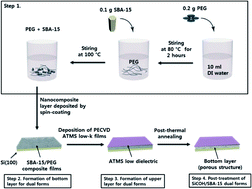Highly robust SiCOH/mesoporous SiO2 ultralow dielectric films with heterostructures†
Abstract
We report here a new dual-coating method for the deposition of SiCOH (elementally descriptive but not representing the stoichiometry) ATMS (allyltrimethylsilane) low-k films on mesoporous SiO2 (SBA-15)/PEG (polyethylene glycol) composite films to improve the dielectric constant and mechanical properties of SiCOH/SBA-15 dual forms. The deposition was achieved via a two-step process: (i) pre-treatment, where SBA-15 was mixed with a dispersion of PEG in DI water, and SBA-15/PEG composite films were formed by spin-coating; and (ii) post-treatment, involving the deposition of SiCOH films on SBA-15s functionalized with PEGs and post-thermal annealing. In comparison with SiCOH-only films, SiCOH/SBA-15 dual forms exhibited a 20% reduction in the dielectric constant without a significant loss of mechanical properties after post-thermal annealing. SEM, TEM, XRD, BET, FT-IR, EP, and XPS results show that the enhanced electrical properties can be attributed to mesoporous SiO2 and additional porosity gained through the removal of PEG and CxHy (thermally labile phases in SiCOH films) after post-thermal annealing. In the SiCOH/SBA-15 dual forms, the SBA-15 layer is expected to function as a soft layer which acts as a buffer layer to prevent the rapid decay of the modulus and hardness.


 Please wait while we load your content...
Please wait while we load your content...